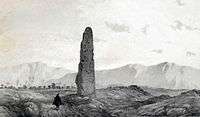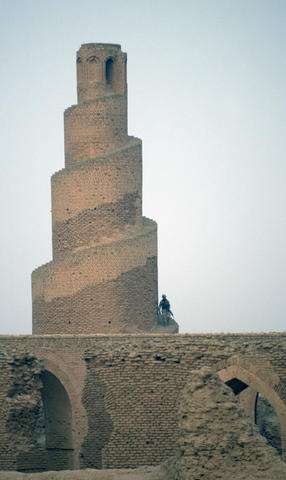Minar (Firuzabad)
The Minar (Persian: منار, literally "pillar") or Minaret (مناره), recorded in medieval Arabic-language Islamic sources as Terbal (طربال Ṭirbāl), was a unique, spiral, tower-like structure built in the centre of the Sassanian circular city of Gōr (modern Firuzabad, Iran). Several theories have been proposed for its purpose. Only the core of the structure remains today.
منار | |
_-_panoramio.jpg) The remaining core of the structure. The stairs and the dome are lost. | |
 Minar Shown within Iran | |
| Alternative name | Terbal, Minaret |
|---|---|
| Location | Gōr, Ardashir-Khwarrah, Pars, Sassanian Empire (near modern Firuzabad, Fars Province, Iran) |
| Coordinates | 28°51′10.3″N 52°31′56.7″E |
| Length | 9 m (30 ft) 20 m (66 ft) if the ruined stairs and outer wall are considered |
| Height | >30 m (98 ft) |
| History | |
| Builder | Ardashir I |
| Material | granite-mortar-masonry |
| Cultures | Sassanian Persia |
| Site notes | |
| Condition | ruined |
| Architecture | |
| Architectural styles | Sassanian |
Description and history
Ardashir I's new city of Gor had a circular plan with the official buildings located at the centre of an inner circle 450 metres (1,480 ft) in radius. The tower-like structure of Terbal was located at the very centre of this circle. Together with Takht-e Neshin, these are the only structures of the city that are made of granite-mortar-masonry. According to Iranica, these two structures may have been confused in medieval Islamic sources, and it is unclear that the names Aywān kiyākhurra (ایوان کیاخوره) (Istakhri), Gunbad-i Kīrmān (or Gīrmān; گنبد گیرمان) and Īrān Garda/Girda[1] (ایران گرده) (Ibn al-Balkhi) mentioned in these sources refer to which structure. Terbal was a 9 metres (30 ft) square structure with more than 30 metres (98 ft) high and spiral in design. It was the core of a stair-tower, and was compared by Ibn Hawqal to a similar edifice at Balkh (a reference to a Buddhist stupa, or possibly a ziggurat). With the width of the destroyed stairs and outer walls added, its actual width is estimated to be about 20 metres (66 ft).[2][3] The remaining structure is hollow, according to the Qajar period writer Forsat-od-Dowleh Shirazi.[4]
 Drawing by Eugène Flandin, who called the structure "the Fire temple (Ateshgah) of Firuzabad"
Drawing by Eugène Flandin, who called the structure "the Fire temple (Ateshgah) of Firuzabad"._Vue_de_la_tour_(NYPL_b12482496-1542746).jpg) Drawing by Pascal Coste, which contains further details
Drawing by Pascal Coste, which contains further details_(14778753704).jpg) A drawing of the Minar with traces of the outer stairs apparent
A drawing of the Minar with traces of the outer stairs apparent
Purpose
_(14594614317).jpg)
Among Western orientalists and travellers, the structure was first observed by Eugène Flandin and Pascal Coste, who noted its uniqueness in Iranian architecture. Prior to Ernst Herzfeld studies of the structure, Terbal was mistakenly thought to be a descendant of the ziggurat, while some thought it is a fire temple, with the Holy Fire (atar) being put at its top to avoid contamination with dust.[3][5][4]
It is hypothesised that the structure may have been part of a government building and symbolised the divine and centralist kingship introduced by Ardashir I. It may have had practical military and civil uses as well, as the tower provided visual contact with some fortifications in the area, and/or may have been used as an observation tower to survey activities during the implementation of the planned scheme of the new city of Gor and the plain. In fact, this grand scheme was centred in Terbal and continued the concentric and radiant pattern of the town, with traces of canals, paths, walls and field borders found up to 10 km distance from this central tower.[3]
According to a newer study, the structure, as also described in medieval sources, may have functioned as a water tower, in such a way that water from nearby elevated sources would flow through tubes and Terbal's hollow core towards its dome, and from there it would be flowed to another tube to flow elsewhere in the town. It is argued that it was not the only purpose of the structure, but it was also part of a temple dedicated to Anahita, the divinity of the Waters (Aban).[4][1][6]
Influence
It is thought that the Terbal was the architectural predecessor of the unique minaret of Great Mosque of Samarra (also known as the malwiya) in Iraq, which was built in the Abbasid period.[7] The minaret itself inspired that of the Mosque of Ibn Tulun in Cairo, Egypt,[7] and recently Philip Johnson's design for the 1976 Chapel of Thanksgiving at Thanks-Giving Square in Dallas, Texas.[8][9][10]
- The unique minaret of the Great Mosque of Kairouan, the oldest surviving Muslim minaret.
 Minaret (the malwiya) of Great Mosque of Samarra, Iraq
Minaret (the malwiya) of Great Mosque of Samarra, Iraq Minaret of Abu Dulaf Mosque, also in Samarra, Iraq
Minaret of Abu Dulaf Mosque, also in Samarra, Iraq Minaret of the Mosque of Ibn Tulun, Egypt, inspired by the malwiya
Minaret of the Mosque of Ibn Tulun, Egypt, inspired by the malwiya Chapel of Thanksgiving at Thanks-Giving Square in Dallas, Texas, built in 1976, inspired by the malwiya
Chapel of Thanksgiving at Thanks-Giving Square in Dallas, Texas, built in 1976, inspired by the malwiya
See also
References
- Strange, Guy Le (2014). Kennedy, Hugh (ed.). Collected works of Guy Le Strange: the medieval Islamic world. London: I.B. Tauris. p. 45. ISBN 9781848856707.
- Bosworth, C. E. (15 December 1986). "ARDAŠĪR-ḴORRA". Encyclopædia Iranica. Retrieved 21 May 2017.
- Huff, Dietrich (15 December 1999). "FĪRŪZĀBĀD". Encyclopædia Iranica. Retrieved 21 May 2017.
- مهرآفرین، رضا؛ خراشادی، سرور؛ جامه بزرگ، عباس؛ «اردشیر خوره: تختگاه اردشیر پاپکان», پیام باستان شناس, بهار و تابستان 1392 – شماره 19 علمی-پژوهشی (دانشگاه آزاد) (14 صص 107–120)
- موسوی، سید احمد؛ «طربال تداوم معماری زیگورات», کیهان فرهنگی, دی 1367, شماره 58, صص 26–27
- مهرآفرين رضا، خراشادي سرور، جامه بزرگ عباس، «اردشير خوره: تختگاه اردشير پاپکان»، پيام باستان شناس: بهار و تابستان 1392، دوره 9، شماره 19، صص 107–120.
- ارجح, اکرم. "جامع کبیر". rch.ac.ir (in Persian). دانشنامه جهان اسلام. Retrieved 21 May 2017.
- "Self-Guided Tour – Guide to Thanks-Giving Square". www.thanksgiving.org. Archived from the original on 26 May 2017. Retrieved 21 May 2017.
- "Travel Tips: Thanks-Giving Chapel's Islamic Design a Visual, Spiritual Gem in Downtown Dallas". Washington Report on Middle East Affairs. Retrieved 21 May 2017.
- Schulze, Franz (1996). Philip Johnson: Life and Work. Chicago: University of Chicago Press. p. 334. ISBN 9780226740584.
External links
| Wikimedia Commons has media related to Pillar of Gor, Firuzabad. |
- «طربال» in Dehkhoda Dictionary (in Persian)
.jpg)